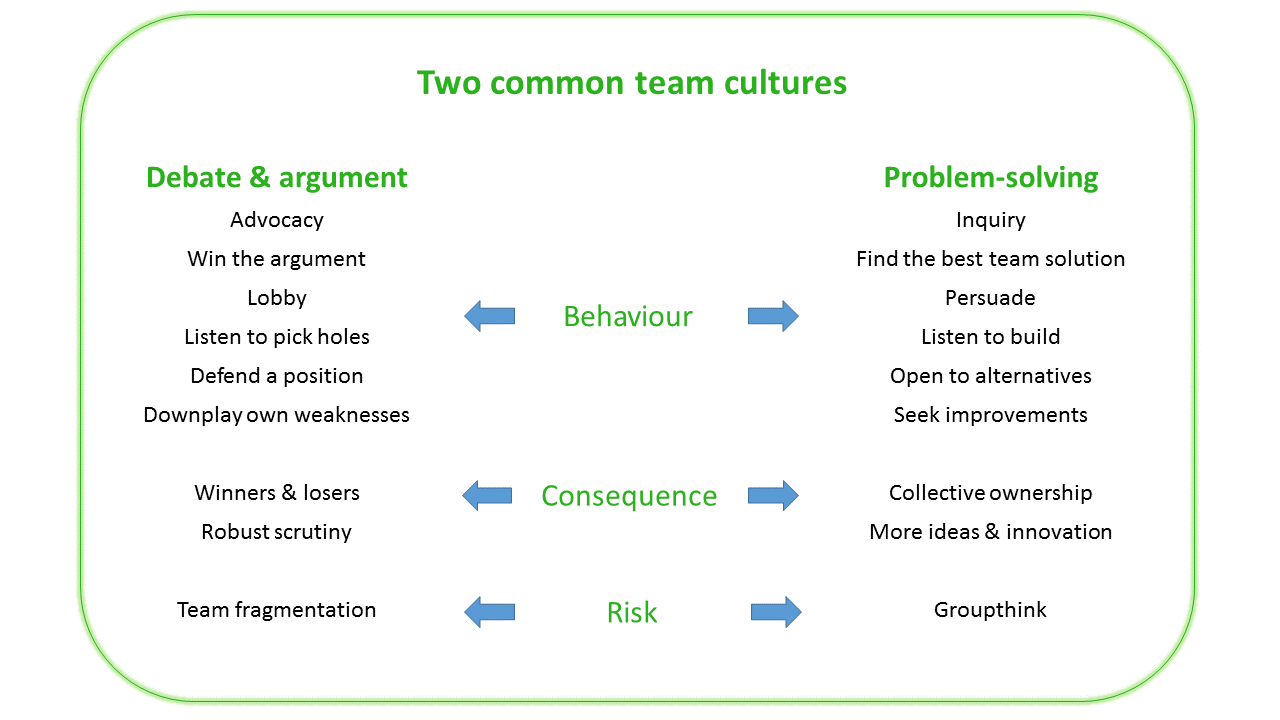From debate to problem-solving
-
 Overview
Overview -
 Exercises
Exercises
Overview
In practice: Creating a culture during discussions focused on inquiry and hearing alternative views to build solutions rather than advocacy and defence of viewpoints.
"Is decision-making in your team more like a heated argument or a cool joint problem-solving session?"
When your team has a tricky issue to resolve, or decision to make, what is the team’s most likely response?
- People put forward their different views and we try to persuade each other that a particular course is the best way forward. The person with the strongest argument wins, or
- We agree, as a team, the criteria that a solution must satisfy. Then we pool our ideas and build several possible solutions. The course of action that best meets the criteria wins.
You may have said “It depends on the issue”, but most teams default to a particular side of the argue-or-analyse divide. And that default position has consequences.

Debate and argument
At one end of the spectrum we have a team that thrives on contesting views. The atmosphere is sharp with cleverness. Think courts of justice, advocacy and adversarial lawyers. People defend their positions, try to persuade others and lobby them to their point of view.
When you spot a weakness in the other side’s argument you use it to discredit their approach, while you don’t mention, or downplay, weaknesses in your own arguments. You listen in order to pick holes in the other position.
In the extreme, you might get upset, angry or personal to score points and win the argument. And that’s the main purpose of the debate – to win the argument.
Problem-solving
At the other extreme we have the investigative team. The atmosphere is thoughtful and considerate. The purpose of the discussion is to develop, test and choose between alternatives.
People remain open to different possibilities and build on each other’s suggestions. Active listening is used to elaborate options.
Different viewpoints are welcomed.
Disagreements and different agendas are explored with a view to extending the decision criteria.
Decision-making is a group activity.
Consequences
Both approaches have virtues. Both have downsides.
Advocacy stresses winners and losers, but competitiveness can give a helpful rigour to the discussion.
On the other hand, it can get personal and cause longer term divisions. It can hide useful information from the team. People can get so committed to particular options that they stop identifying with the team as a whole.
All of these are major downsides.
Problem-solving is more cohesive and considers more options.
But it is longer and more demanding of team members. Take away a sense of individuality and groupthink is always a danger.
Conclusion
On balance, the research shows that the problem-solving approach produces more innovation, better decisions and more collective ownership of the eventual decision.
The quickest guide to your own team’s approach? How your people listen to each other. Are they building possibilities or defending positions?
The real solution is to combine the best from both approaches.
Exercises
Exercise - Robust debate vs joint problem-solving
This exercise will help your team find the right balance between robust debate and collective problem-solving.
Exercise - Improving your decision-making process
This exercise looks at the gold-standard decision making process for important decisons and helps you to review your normal process against this standard.
Exercise - Active listening
An exercise to practise Active listening with two colleagues, and receive feedback on what you did well and what you might improve.
